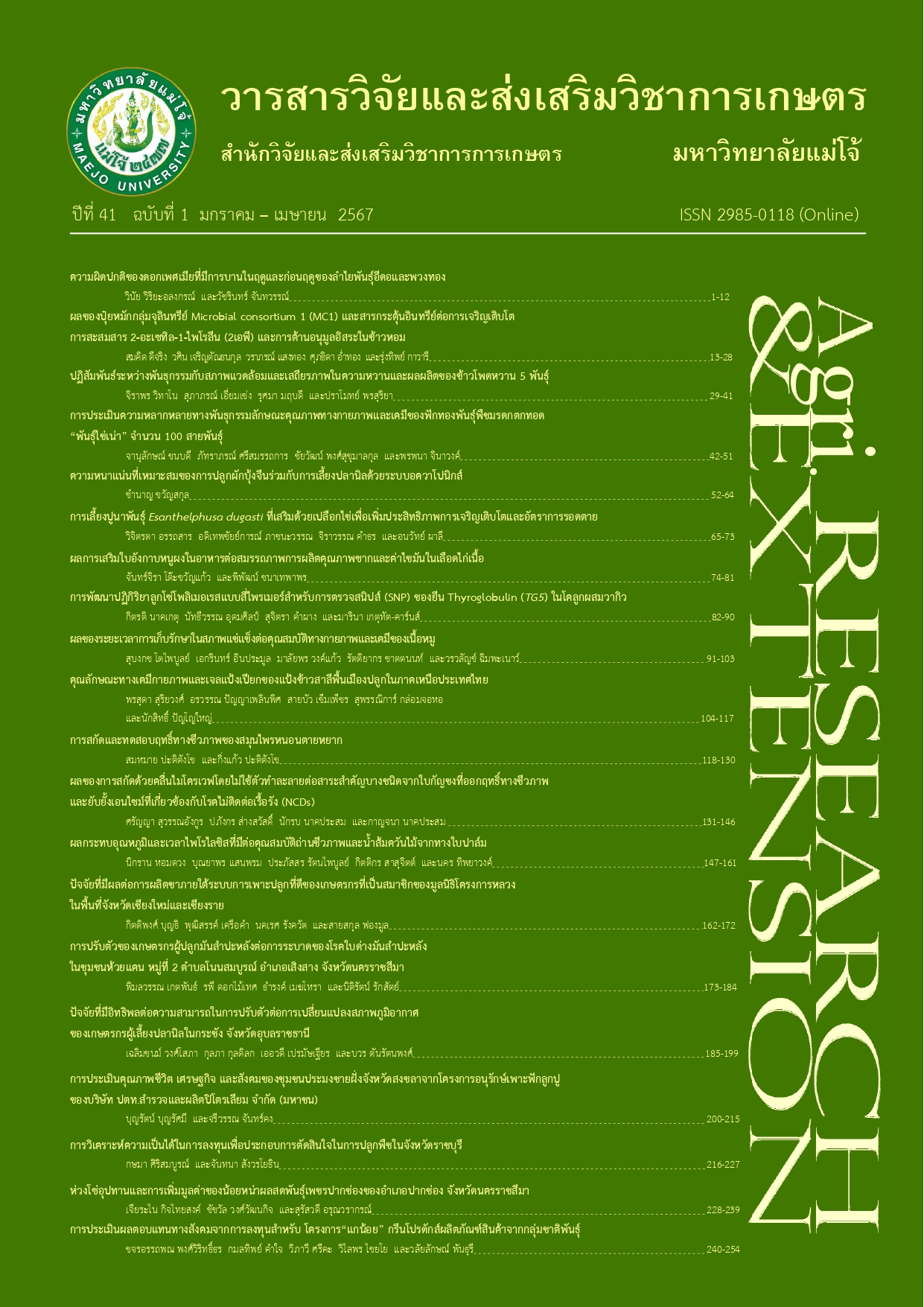ผลของการสกัดด้วยคลื่นไมโครเวฟโดยไม่ใช้ตัวทำละลายต่อสารสำคัญบางชนิดจากใบกัญชง ที่ออกฤทธิ์ทางชีวภาพและยับยั้งเอนไซม์ที่เกี่ยวข้องกับโรคไม่ติดต่อเรื้อรัง (NCDs)
DOI:
https://doi.org/10.14456/jare-mju.2024.12คำสำคัญ:
การสกัดด้วยไมโครเวฟโดยไม่ใช้ตัวทำละลาย , ใบกัญชง , โรคไม่ติดต่อเรื้อรัง , ฤทธิ์ทางชีวภาพบทคัดย่อ
โรคไม่ติดต่อเรื้อรัง (NCDs) เป็นปัญหาสำคัญด้านสาธารณสุขของประเทศไทยและทั่วโลก ก่อให้เกิดการสูญเสียทางเศรษฐกิจ และการใช้ยารักษาโรค NCDs ส่งผลให้เกิดอาการข้างเคียงที่ไม่พึงประสงค์ ดังนั้นการใช้สารสกัดจากพืชจึงเป็นทางเลือกที่ดีที่จะใช้ป้องกันการเกิดโรคเหล่านี้ งานวิจัยนี้จึงมีวัตถุประสงค์เพื่อศึกษาผลของการใช้คลื่นไมโครเวฟ โดยไม่ใช้ตัวทำละลายในการสกัดสารสำคัญจากใบกัญชงต่อการออกฤทธิ์ทางชีวภาพ ทั้งนี้สารสกัดจากใบกัญชงถูกสกัดด้วยคลื่นไมโครเวฟกำลังไฟฟ้า 150, 250 และ 350 วัตต์ เป็นระยะเวลา 15 และ 30 นาที เพื่อทดสอบการออกฤทธิ์ต้านอนุมูลอิสระด้วยวิธี DPPH, FRAP, การดักจับอิออนของโลหะ การกำจัดอนุมูลไฮดรอกซิล และการยับยั้งเอนไซม์ ACE (โรคความดันโลหิตสูง) เอนไซม์ DPP–IV (โรคเบาหวานชนิดที่ 2) เอนไซม์ α–amylase เอนไซม์ α–glucosidase (โรคเบาหวานชนิดที่ 2 และโรคอ้วน) และเอนไซม์ HMG–CoA reductase (ภาวะไขมันในเลือดสูง) สารสำคัญจากใบกัญชงที่สกัดด้วยคลื่นไมโครเวฟกำลังไฟ 350 วัตต์ เป็นเวลา 15 นาที มีประสิทธิภาพขจัดอนุมูลอิสระ DPPH, FRAP มีความสามารถในการดักจับอิออนของโลหะสูงที่สุด มีค่า EC50 เท่ากับ 0.75, 0.39 และ 1.16 มก./มล ตามลำดับ และมีประสิทธิภาพยับยั้งเอนไซม์ ACE, α–amylase และ α–glucosidase สูงที่สุด มีค่า IC50 เท่ากับ 0.35, 0.14 และ 0.23 มก./มล ตามลำดับ นอกจากนี้สารสำคัญจากใบกัญชงที่สกัดด้วยคลื่นไมโครเวฟกำลังไฟ 250 วัตต์ เป็นเวลา 30 นาที มีประสิทธิภาพในยับยั้งเอนไซม์ DPP-IV (IC50=0.37 มก./มล.) และ HMG–CoA Reductase (IC50=1.18 มก./มล.) สูงที่สุด การศึกษานี้แสดงให้เห็นว่าสารสกัดจากใบกัญชงมีศักยภาพทาง โภชนเภสัชซึ่งสามารถใช้ป้องกันการสูญเสียจากโรค NCDs ได้
เอกสารอ้างอิง
Algariri, K., I.J. Atangwho, K.Y. Meng, M.Z. Asmawi, A. Sadikun and V. Murugaiyah. 2014. Antihyperglycemic and toxicological evaluations of extract and fractions of Gynura procumbens leaves. Tropical Life Sciences Research 25(1): 75-93.
Ansari, P., M.P. Hannon-Fletcher, P.R. Flatt, Y.H.A. Abdel-Wahab. 2021. Effects of 22 traditional anti-diabetic medicinal plants on DPP–IV enzyme activity and glucose homeostasis in high-fat fed obese diabetic rats. Bioscience Reports 41(1): BSR20203824.
Awosika, T.O. and R.E. Aluko. 2019. Inhibition of the In Vitro activities of α–amylase, α–glucosidase and pancreatic lipase by yellow field pea (Pisum sativum L.) protein hydrolysates. International Journal of Food Science and Technology 54(6): 2021-2034.
Camps, J., E. Rodríguez-Gallego, A. García-Heredia, I. Triguero, M. Riera-Borrull, A. Hernández-Aguilera, F. Luciano-Mateo, S. Fernández-Arroyo and J. Joven. 2014. Paraoxonases and chemokine (C–C Motif) ligand-2 in noncommunicable diseases. Advances in Clinical Chemistry 63: 247-308.
Casedas, G., C. Moliner, F. Maggi and E. Mazzara. 2022. Evaluation of two different Cannabis sativa extracts as antioxidant and neuroprotective agents. Frontiers in Pharmacology 13(2022): 1-11. DOI:10.3389/fphar.2022.1009868.
Chalopagorn, P. and P. Klomsakul. 2017. α-amylase and α-glucosidase inhibitory activities of Ceasalpinia sappan, Ficus foveolata and Eurycoma longifolia extracts. Research Journal Phranakhon Rajabhat: Science and Technology 12(1): 63-73.
Choi, S.I., H.A. Lee and J.S. Han. 2016. Gynura procumbens extract improves insulin sensitivity and suppresses hepatic gluconeogenesis in C57BL/KsJ-db/db mice. Nutrition Research and Practice 10(5): 507-515.
Deo, P., E. Hewawasam, A. Karakoulakis, D.J. Claudie, R. Nelson, B.S. Simpson, N.M. Smith and S.J. Semple. 2016. In Vitro inhibitory activities of selected Australian medicinal plant extracts against protein glycation, angiotensin converting enzyme (ACE) and digestive enzymes linked to type II diabetes. BMC Complementary and Alternative Medicine 16(1): 1-11.
Dhobi, M., V. Mandal and S. Hemalatha. 2009. Optimization of microwave assisted extraction of bioactive flavonolignan-silybinin. Journal of Chemical Metrology 3(1): 13-23.
Eidenberger, T., M. Selg and K. Krennhuber. 2013. Inhibition of dipeptidyl peptidase activity by flavonol glycosides of guava (Psidium guajava L.): a key to the beneficial effects of guava in type II diabetes mellitus. Fitoterapia 89: 74-79.
Girgih, A.T., C.C. Udenigwe and R.E. Aluko. 2011. In Vitro antioxidant properties of hemp seed (Cannabis sativa L.) protein hydrolysate fractions. Journal of the American Oil Chemists' Society 88(3): 381-389.
Hajar, R. 2017. Risk factors for coronary artery disease: historical perspectives. Heart Views. 18(3): 109-114.
Hassan, Z., M.F. Yam, M. Ahmad and A.P.M. Yusof. 2010. Antidiabetic properties and mechanism of action of Gynura procumbens water extract in streptozotocin-induced diabetic rats. Molecule 15(12): 9008-9023.
Hoe, S.Z. and S.K. Lam. 2005. Hypotensive activity of an aqueous fraction of Gynura procumbens and possible mechanisms of action (Hypertension, Basic 1 (H), The 69th Annual Scientific Meeting of the Japanese Circulation Society). Circulation Journal: Official Journal of the Japanese Circulation Society 69: 348.
Hoe, S.Z., M.Y. Kamaruddin and S.K. Lam. 2007. Inhibition of angiotensin-converting enzyme activity by a partially purified fraction of Gynura procumbens in spontaneously hypertensive rats. Medical Principles and Practice 16(3): 203-208.
Ismail-Suhaimy, N.W., S.S.A. Gani, U.H. Zaidan, M.I.E. Halmi and P. Bawon. 2021. Optimizing conditions for microwave-assisted extraction of polyphenolic content and antioxidant activity of Barleria lupulina Lindl. Plants 10(4): 682. [Online]. Available https://doi.org/10.3390/plants10040682.
Kurtulbas, E., S. Sevgen, R. Samli and S. Sahin. 2022. Microwave-assisted extraction of bioactive components from peach waste: Describing the bioactivity degradation by polynomial regression. Biomass Conversion and Biorefinery DOI:10.1007/s13399-022-02909-z
Lepping, P., J. Delieu, R. Mellor, J.H.H. Williams, P.R. Hudson and C. Hunter-Lavin. 2011. Antipsychotic medication and oxidative cell stress: a systematic review. Journal of Clinical Psychiatry 72(3): 273-285.
Mun’im, A., S. Nurpriantia, R. Setyaningsih and R.R. Syahdi. 2017. Optimization of microwave-assisted extraction of active compounds, antioxidant activity and angiotensin converting enzyme (ACE) inhibitory activity from Peperomia pellucida (L.) Kunth. Journal of Young Pharmacists 9(1):73-78.
Ng, H.K., T.F. Poh, S.K. Lam and S.Z. Hoe. 2013. Potassium channel openers and prostacyclin play a crucial role in mediating the vasorelaxant activity of Gynura procumbens. BMC Complementary and Alternative Medicine 13: 1-11.
Othman, S.N., A.N. Mustapa and K.H.K. Hamid. 2020. Total phenol content of Clinacanthus nutans Lindau (C. nutans) medicinal plant extracted using vacuum solvent-free microwave extraction (SFME). IOP Conference Series: Materials Science and Engineering 736(2020): 1-9. DOI:10.1088/1757-899X/736/2/022054
Panutat, S., C. Chuto, C. Nuntawan, A. Pumsrisawat and T. Pruksacheva. 2017. Caring for the elderly with malnutrition. Journal of Ratchathani Innovative Health Sciences 1: 1-13.
Poh, T.F., H.K. Ng, S.Z. Hoe and S.K. Lam. 2013. Gynura procumbens causes vasodilation by inhibiting angiotensin II and enhancing bradykinin actions. Journal of Cardiovascular Pharmacology 61(5): 378-384.
Rojanapithayakorn, W. 2019. Health situation and trends in Thailand, 2018-2020. Journal of Health Science 28(2): 185-186.
Sahin, S., R. Samli, A.S.B. Tan, F.J. Barba, F. Chemat, G. Cravotto and J.M. Lorenzo. 2017. Solvent-free microwave-assisted extraction of polyphenols from olive tree leaves: antioxidant and antimicrobial properties. Molecules 22(7): 1056. DOI: 10.3390/molecules22071056.
Suedee, A. 2017. Microwave-assisted extraction of active compounds from medicinal plants. EAU Heritage Journal Science and Technology 11(1): 1-14.
Tatke, P. and Y. Jaiswal. 2011. An overview of microwave assisted extraction and its applications in herbal drug research. Research Journal of Medicinal Plant 5: 21-31.
ดาวน์โหลด
เผยแพร่แล้ว
รูปแบบการอ้างอิง
ฉบับ
ประเภทบทความ
สัญญาอนุญาต
ลิขสิทธิ์ (c) 2024 วารสารวิจัยและส่งเสริมวิชาการเกษตร

อนุญาตภายใต้เงื่อนไข Creative Commons Attribution-NonCommercial-NoDerivatives 4.0 International License.
บทความนี้ได้รับการเผยแพร่ภายใต้สัญญาอนุญาต Creative Commons Attribution-NonCommercial-NoDerivatives 4.0 International (CC BY-NC-ND 4.0) ซึ่งอนุญาตให้ผู้อื่นสามารถแชร์บทความได้โดยให้เครดิตผู้เขียนและห้ามนำไปใช้เพื่อการค้าหรือดัดแปลง หากต้องการใช้งานซ้ำในลักษณะอื่น ๆ หรือการเผยแพร่ซ้ำ จำเป็นต้องได้รับอนุญาตจากวารสาร





